グローバル:個別株 - 勝者と敗者を選ぶ
レッスンの学習目標:
- Learn the benefits and risks of investing in individual stocks. You’ll understand how stock-picking gives you control and the potential for higher rewards, but also comes with more risk and the need for careful research.
- Understand what ETFs are and how they offer easy diversification. You’ll see how ETFs give access to many assets in one investment and why they’re a low-cost, flexible option for many investors.
- Explore mutual funds and how professional management can help or hurt performance. You’ll learn how mutual funds work, their advantages in access and management, and their drawbacks like higher fees and limited trading flexibility.
- Gain insights into index investing as a long-term strategy. You’ll understand why tracking a whole market index can provide steady growth, low fees, and lower risk over time.
- See how ETFs can be used for building a full portfolio. You’ll discover how ETFs allow easy access to different sectors and asset classes, helping you customize a low-cost, diversified investment strategy.
A. Individual Stocks: Picking the Winners and Losers
個別株 allow investors to own a share of a single company. This approach can be highly rewarding but also carries significant risks, as the performance of a single stock can be volatile and unpredictable.
長所:
- 高い成長の可能性: Individual stocks can provide significant returns if a company performs well.
- Control over investments: Investors can choose specific companies they believe will outperform the market.
- 配当金: Many companies pay dividends, offering a steady income stream to shareholders.
短所:
- High risk: Stock prices can be highly volatile, and poor company performance can lead to significant losses.
- 調査が必要: Successful stock picking requires extensive research and knowledge of the company, industry, and market conditions.
- Lack of diversification: Investing in individual stocks means you’re putting all your eggs in one basket, increasing the risk if the stock underperforms.
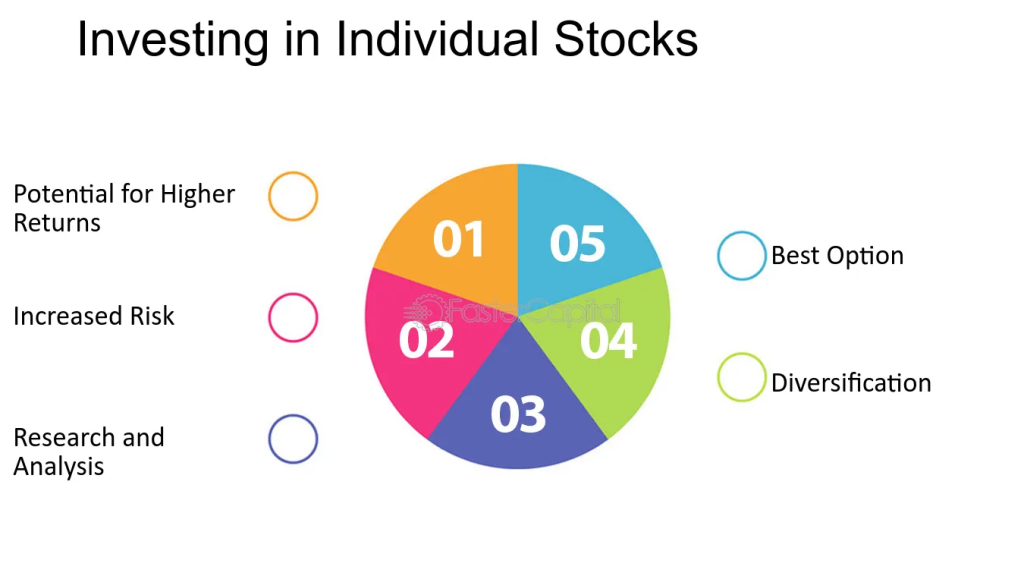
形: Investing in Individual Stocks
説明:
This pie chart highlights the five key factors associated with investing in individual stocks: potential for higher returns, increased risk, research and analysis, 多様化、 そして choosing the best option. Each section represents an essential aspect investors should consider when making decisions about individual stocks.
重要なポイント:
- より高い収益の可能性 is a significant advantage of investing in individual stocks.
- 増大するリスク is inherent in individual stock investments, requiring careful management.
- Research and analysis are crucial to understanding individual stock performance and market conditions.
- 多様化 helps reduce risk by balancing investments across different stocks.
- Selecting the best option involves evaluating stocks based on performance, risk, and market trends.
情報の応用:
Investors can use this information to understand the benefits and challenges of investing in individual stocks. By focusing on research and diversification, they can manage risks while aiming for higher returns. This framework aids in creating a balanced stock portfolio tailored to an investor’s リスク許容度 and financial goals.
B. Exchange-Traded Funds (ETFs): Harnessing the Power of Diversification
ETF are investment funds that trade on stock exchanges, offering exposure to a basket of securities. They can include stocks, bonds, commodities, or a combination of assets, making them a popular choice for diversification.
長所:
- 多様化: ETFs allow investors to own a broad range of assets, reducing risk by spreading exposure across multiple companies or sectors.
- 流動性: ETFs are traded throughout the day on exchanges, making them highly liquid and easy to buy or sell.
- Low costs: ETFs generally have lower expense ratios compared to mutual funds, making them cost-efficient.
- 透明性: ETFs usually track a specific index or asset, making it easy for investors to understand what they’re investing in.
短所:
- Market risk: While ETFs are diversified, they still reflect the overall market movements, so they can lose value if the entire market declines.
- Lower growth potential: Because ETFs are diversified, they may not offer the same growth potential as high-performing individual stocks.
- Trading fees: Frequent buying and selling of ETFs can incur trading fees, reducing overall returns.
Important Terms to Know:
- 経費率: The annual fee charged by an ETF to cover management and operational costs.
- トラッキングエラー: The difference between the performance of the ETF and the index it tracks.
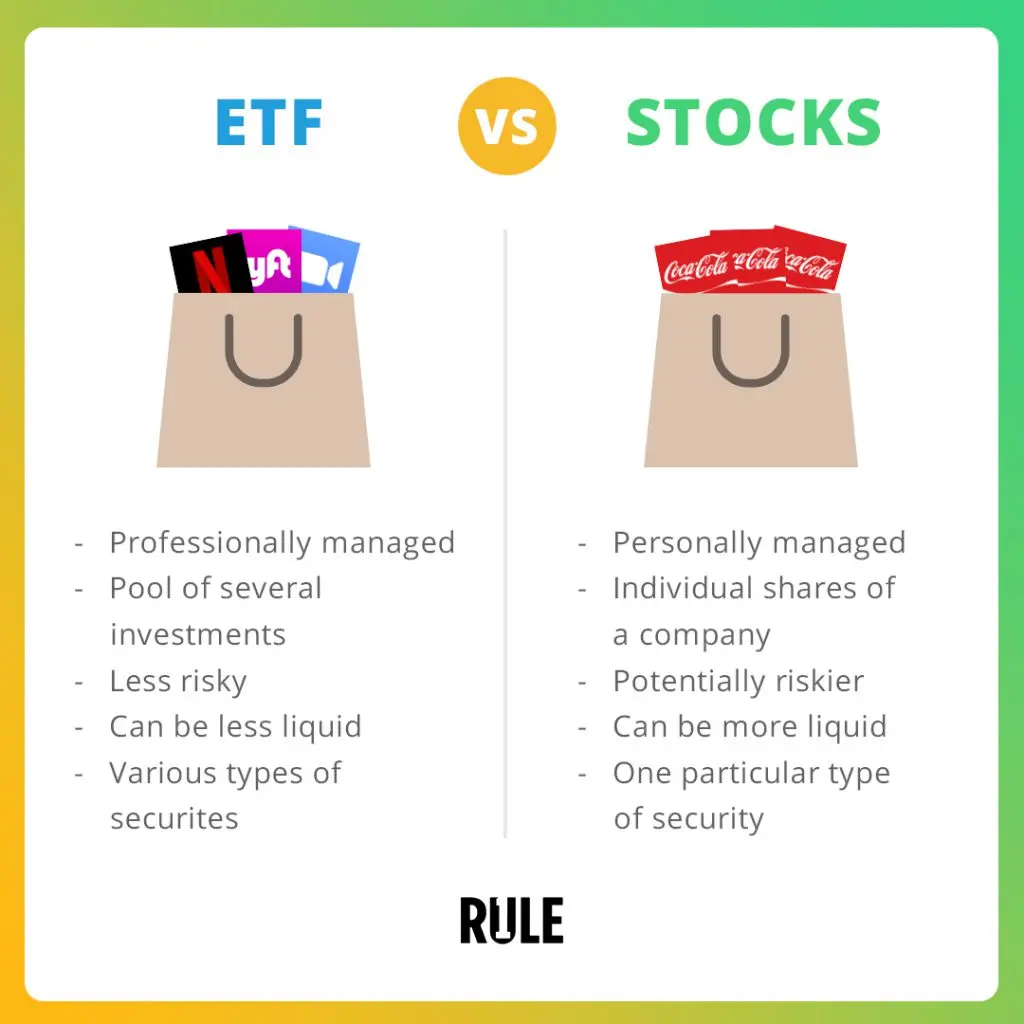
形: ETF vs. Stocks
説明:
This image compares ETFs (Exchange-Traded Funds) そして 株式. ETFs represent a professionally managed pool of various investments, making them less risky and more diversified, although they can be less liquid. In contrast, stocks are personally managed investments in individual companies, offering potential for higher gains but with greater risks and better liquidity.
重要なポイント:
- ETF are diversified, professionally managed, and generally less risky, but they may offer lower liquidity compared to stocks.
- 株式 involve investing in specific companies, offering potentially higher returns with higher risks そして better liquidity.
- ETFs contain various securities, while stocks focus on one company at a time.
情報の応用:
Understanding the differences between ETF そして 株式 helps investors make informed decisions based on their リスク許容度 and investment goals. Those seeking diversification and lower risks may prefer ETFs, while investors aiming for potentially higher returns might focus on individual stocks.
C. Mutual Funds: Letting the Pros Manage Your Money
Mutual funds pool money from many investors to invest in a diversified portfolio of stocks, bonds, or other securities. They are actively managed by professional fund managers who aim to outperform the market.
長所:
- プロフェッショナルな管理: Mutual funds are managed by experienced professionals who make investment decisions on behalf of investors.
- 多様化: Like ETFs, mutual funds invest in a variety of assets, reducing risk through diversification.
- Access to a wide range of assets: Mutual funds provide exposure to a wide range of securities, including stocks, bonds, and other assets that may be difficult for individual investors to access.
短所:
- 手数料が高い: Mutual funds typically have higher expense ratios due to active management, which can reduce overall returns.
- Less flexibility: Mutual funds are bought and sold at the end of the trading day, so investors cannot take advantage of intraday price movements.
- Underperformance risk: Actively managed funds do not always outperform the market, and in some cases, they can underperform passive investments like ETFs.
Important Terms to Know:
- Net Asset Value (NAV): The per-share value of the mutual fund, calculated at the end of each trading day.
- Load Fees: A commission or sales charge applied when buying or selling mutual fund shares.
Difference Between a Mutual Fund and ETF:
- 取引の柔軟性: ETFs trade throughout the day like stocks, while mutual funds are only traded once per day at the closing NAV.
- 料金: ETFs generally have lower fees and are passively managed, while mutual funds often have higher fees due to active management.
- 経営スタイル: ETFs are typically passively managed, tracking an index, while mutual funds are usually actively managed by professionals.
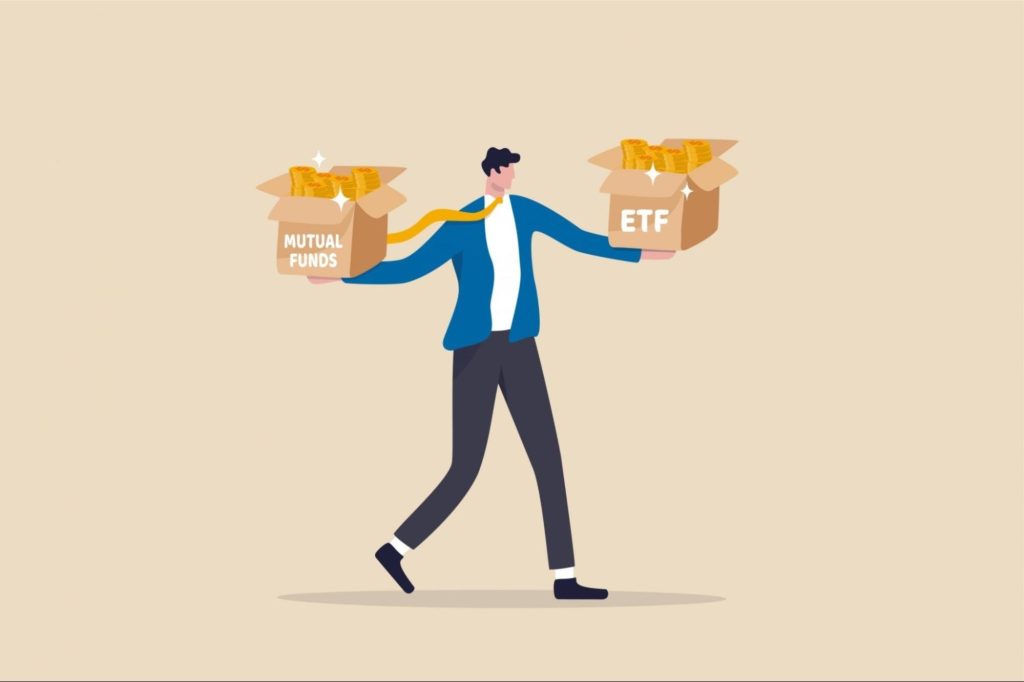
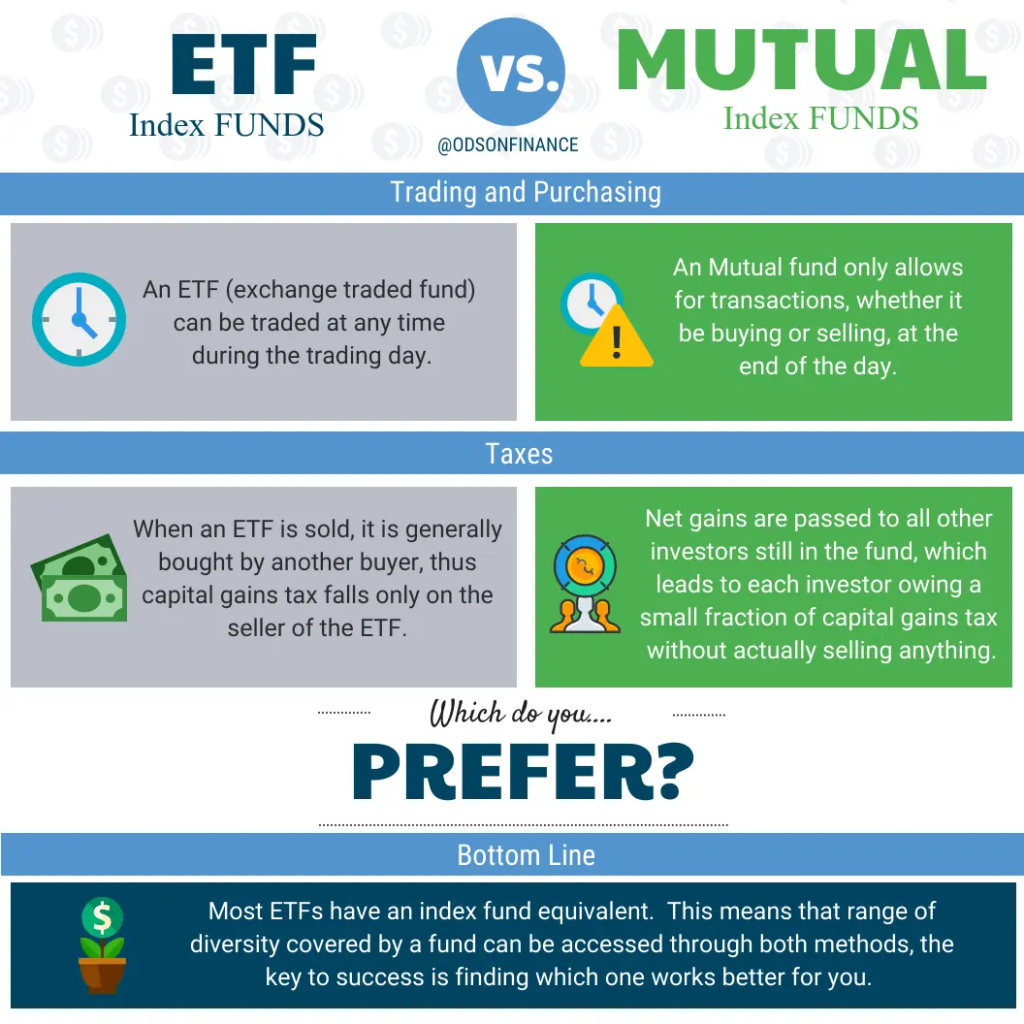
形: ETF Index Funds vs. Mutual Index Funds
説明:
This image compares ETF (Exchange-Traded Funds) and Mutual Index Funds. ETFs can be traded at any time during the trading day, while Mutual Index Funds only allow transactions at the end of the day. Regarding 税金, selling an ETF incurs a キャピタルゲイン税 for the seller, whereas net gains in Mutual Funds are distributed among all investors, leading to a small fraction of capital gains tax even without selling.
重要なポイント:
- ETF offer flexibility in trading, while ミューチュアルファンド restrict transactions to the end of the day.
- キャピタルゲイン税 on ETFs is only applicable to the seller, whereas Mutual Fund investors might incur taxes without selling.
- Both have index fund equivalents offering similar exposure.
情報の応用:
Understanding the differences between ETF そして Mutual Index Funds helps investors choose based on trading flexibility, 税金の影響、 そして investment goals. Those seeking active trading opportunities might prefer ETFs, while investors who are less concerned with daily trading might opt for Mutual Funds.
D. The Power of Index Investing: Steady Growth and Peace of Mind
Index investing involves investing in a portfolio that tracks a specific index, such as the S&P 500 or the FTSE 100. This strategy allows investors to match the performance of the broader market, providing steady growth over time without the need for active management.
長所:
- Low fees: Index funds and ETFs typically have very low fees compared to actively managed funds, as they simply replicate an index.
- Steady growth: Index investing offers long-term growth by tracking the overall market, which tends to increase in value over time.
- リスクの軽減: By investing in a wide array of companies, index investing reduces the risk associated with individual stock performance.
E. ETFs for Portfolio Investing: Accessing Multiple Indexes with Ease
ETF designed for portfolio investing provide easy access to multiple indexes, sectors, or asset classes. This allows investors to build a diversified portfolio with minimal effort, using ETFs that target specific markets or strategies.
長所:
- Portfolio diversification: Investors can gain exposure to multiple asset classes and sectors using different ETFs, creating a balanced portfolio.
- Customizable strategy: ETFs provide the flexibility to invest in specific sectors, geographies, or asset classes based on the investor’s goals.
- Cost-efficient: ETFs typically have lower fees than mutual funds, making them an attractive option for building a diversified portfolio.
短所:
- 市場のボラティリティ: While ETFs offer diversification, they are still subject to overall market fluctuations, meaning they can lose value during downturns.
- トラッキングエラー: Some ETFs may not perfectly match the performance of the index they are designed to replicate, which could impact returns.
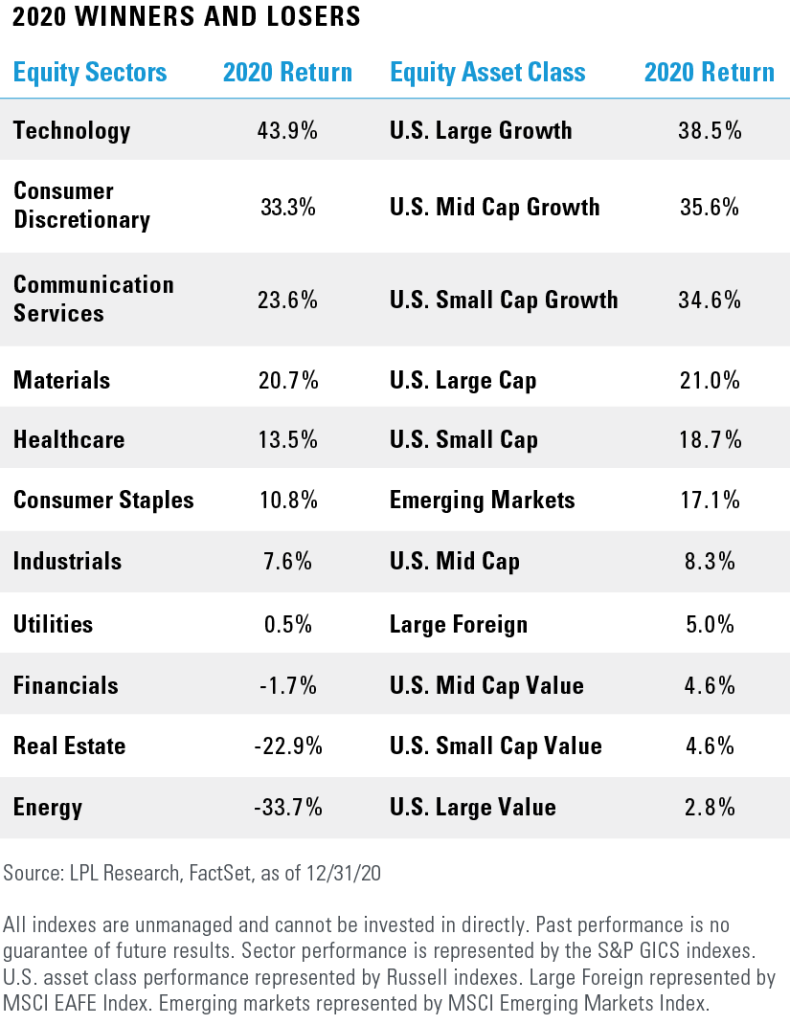
形: 2020 Winners and Losers
説明:
This table shows the 2020 performance of various equity sectors and corresponding asset classes. It ranks the sectors based on their returns, with テクノロジー leading at 43.9%, followed by 消費者向け裁量財 at 33.3%. The table also highlights the U.S. Large Growth asset class as a top performer with 38.5% return. At the bottom, 不動産 そして エネルギー posted significant negative returns of -22.9% そして -33.7%, respectively.
重要なポイント:
- テクノロジー そして 消費者向け裁量財 were the top-performing sectors in 2020.
- U.S. Large Growth そして U.S. Mid Cap Growth were the strongest asset classes.
- 不動産 そして エネルギー faced the largest declines among sectors.
- The best returns were generally in growth-oriented sectors and asset classes.
情報の応用:
This data helps investors understand which sectors and asset classes performed well or poorly during 2020, potentially guiding future investment strategies. It can also assist in analyzing market trends during economic downturns or recoveries. Understanding these trends allows investors to make more informed asset allocation decisions based on sector performance そして growth potential.
結論
Mastering the art of diversification involves understanding various investment vehicles like 個別株, ETF, mutual funds、 そして index investing. Each vehicle has its own pros and cons, and the best choice depends on the investor’s risk tolerance, investment goals, and time horizon. 個別株 offer high growth potential but come with greater risk, while ETF そして mutual funds provide diversification at a lower cost. Index investing offers steady, long-term growth, while portfolio investing with ETFs provides the flexibility to customize and balance investments across various sectors and asset classes.
主なレッスン情報:
- 個別株 offer the chance for high returns そして 配当金, but come with high risk, especially if the company performs poorly. Picking the right stocks takes time, research, and understanding of the market.
- ETF provide 多様化, liquidity、 そして low costs. They allow you to invest in many companies or sectors at once, reducing your risk. However, market risk still applies, and frequent trading may lead to extra fees.
- Mutual funds are managed by professionals and give you access to a wide range of assets. But they often come with higher fees, less trading flexibility, and don’t always perform better than simpler investments like ETFs.
- Index investing helps you follow the performance of a market over time. It offers steady growth, low fees、 そして less risk by investing in many companies at once instead of trying to pick winners.
- ETFs for portfolio investing allow you to build a diversified investment plan using different types of ETFs for specific goals, like investing in sectors, countries, 、 または asset types. They are cost-effective and customizable but can still face market ups and downs.
- Past performance data, like the 2020 sector results, can help investors understand which areas of the market perform well during certain times. For example, テクノロジー そして 消費者向け裁量財 led in growth, while エネルギー そして 不動産 saw losses. These trends help with future investment planning.
閉会の辞:
Knowing the differences between stocks, ETFs, mutual funds, and index investing allows you to build a smart and personalized investment plan. These tools can help you balance 危険, growth、 そして 費用 based on your goals and comfort level.

